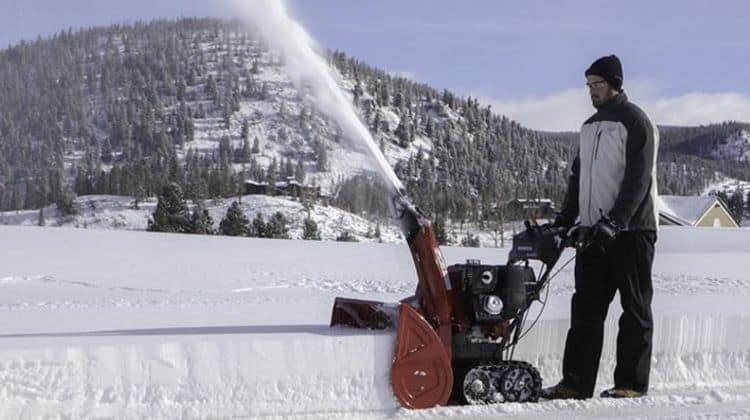In Brief: Snow Blower Won’t Start – How To Troubleshoot
Snowblowers fail to start for a variety of reasons. If you hit a hard object, check the flywheel key. Check the switches and refuel. Add fuel stabilizer to clear residue and add an engine primer. Check and replace spark plugs, ignition coils, recoil springs, and filters. Clean and rebuild the carburetor. If all else fails, call a professional.
Snowblower starting issues are commonplace, and most of the time they are relatively easy to fix.
Snow Blower Won’t Start – How To Troubleshoot
The following troubleshooting steps are organized into the order you should try them. If you reach the end and to no avail, you will need to call a professional.
Always follow safety procedures when performing snowblower maintenance.
Did You Hit A Hard Object?
Most problems relating to snowblowers that will not start are after a period of non-use.
However, if yours has stopped functioning after hitting a hard object, you should check the flywheel key first.
The flywheel key acts as an interface between the crankshaft and the flywheel. It breaks to protect the engine in the event of hitting a hard object.
Remove the flywheel and check the flywheel key. If it has been sheared in half, then you will need to purchase a new one.
Check The Start Switches
Unless you use your snowblower all year round, it has probably been a while since you have used it.
Therefore, you may have forgotten to pull a switch or lever that is required to start up.
Grab your owner’s manual and ensure that you follow the instructions for starting the snowblower to the letter, taking note of all the switches and button presses you need to make.
Once you have ensured that you have followed the correct procedure, you can move on to further troubleshooting.
Check The Fuel
Check that your snowblower has enough fuel in it.
If it does not have fuel in it, then that will be the problem. Simply add some fuel and the snowblower should start.
If it does have fuel in it, and you have just taken it out of the shed or garage for the first time since last year, then you will need to drain the fuel and add some fresh gas.
Fuel left in the snowblower for long periods will thicken. To remedy this, add some fuel stabilizer into the tank and crank the start cord a few times to pump it through.
You may have to leave it for a couple of hours to see if it worked.
Prime the Engine

Gas engines sometimes require a primer to start in cold weather. To prime the engine, you will need to pump a small amount of fuel into the carburetor.
Using your manual, locate the flexible primer bulb. It will be made of silicon or rubber and will be located near the carburetor. Press it a few times, then start the snowblower.
Try starting the engine a few times before giving up and moving on to the next step.
Check the Spark Plug
The next step is to check the spark plug for wear and damage. Remove the spark plug according to the owner’s manual.
Upon inspection, the porcelain insulator should be free from cracks and the electrodes should not have too much buildup and should look in good shape. If you have one, you can use a spark plug tester to check if it has been damaged beyond use.
As long as there is no damage, you can simply clean the spark plug and put it back in. Otherwise, you will need to replace it.
Check the Ignition Coil
If you have established that the spark plug is functioning correctly, you will want to check that the ignition coil is also in working condition.
You can buy ignition coil testers online for a reasonable price.
If the ignition coil is defective, you will need to buy a replacement for it.
Check the Recoil Starter
If you have a model with a starter cord, you will want to check that the starting mechanism is working correctly.
Use your owner’s manual to locate the recoil spring and check that it functions properly. When functioning properly, it should transfer the starter cord to the pulley. If it does not, the engine will be unable to start.
You can usually replace an individual recoil spring, but if there looks to be significant wear to other related components it might be better to just replace the entire assembly.
Check the Fuel Line
The next port of call is the fuel line. The fuel line should be flexible, but it can become brittle for various reasons.
When the fuel line becomes brittle it is prone to damage, which will result in fuel leaks and a reduction in the amount of fuel that reaches the carburetor.
If the fuel line seems compromised in any way, you will need to buy and fit a replacement.
Check the Air Filter
Now you should locate the air filter using your owner’s manual. It will be located on the carburetor, as the purpose of the carburetor is to mix the fuel with air.
A dirty air filter can prevent starting in some instances, so remove it and check it for dirt. If it appears clogged, using a can of compressed air or a vacuum to clean it.
You can quickly replace the air filter and try to start the snowblower again.
Clean the Carburetor

While you have the air filter off, you may as well clean the carburetor.
Over time, the carburetor can get clogged and the delicate balance of air and fuel it mixes will be difficult for it to produce.
You can buy carburetor cleaning solvents at affordable prices. Apply some of this according to the instructions and allow it to do its work.
You can then replace the air filter and cover. Try starting the engine again.
Rebuild or Replace the Carburetor
If the snowblower still will not start, and you noticed significant residue or wear in the carburetor, you may need to either rebuild or replace it.
Rebuilding kits come with all the accessories that experience the most wear on a carburetor. With a thorough clean and rebuild, your carburetor should be back in working condition.
However, if there is irreparable damage you will need to replace the whole carburetor.
It is better to exhaust all of the other options before replacing the carburetor as it would be a waste of money if it turned out the problem was something else.
Call A Professional
If you have reached the end of this guide and you have still not found the source of the issue, you will need to call a professional.
Depending on how long you have had the snowblower, it might still be under warranty. Check the guidance that came with your snowblower to see if you are eligible for free or cheap repairs.
Otherwise, look for a professional in your area that has experience repairing snowblowers. Make sure to get a quote and compare that to the cost of buying a new snowblower before you commit to anything.
Summary
We hope that this article has helped you to get your snowblower back into working condition.
With a little care and attention, you can bring a broken snowblower back to life with relatively low-cost solutions.
If this article has helped, or you have any more tips for others who are experiencing snowblower problems, please feel free to leave a comment in the section below.


